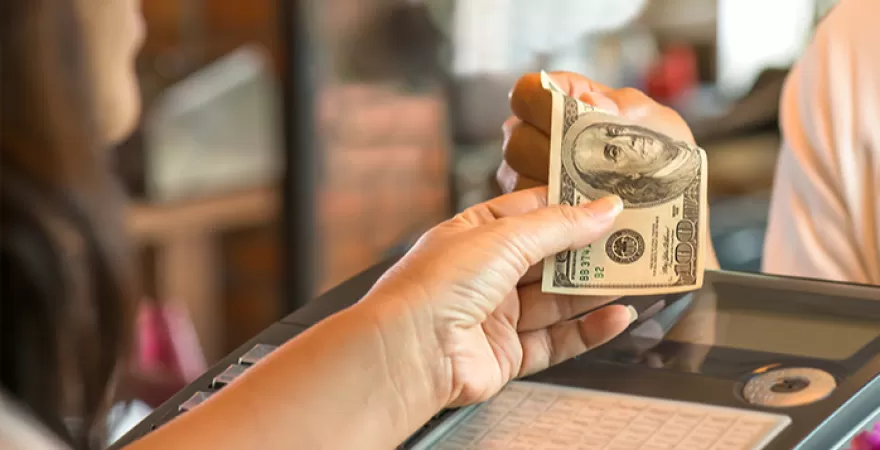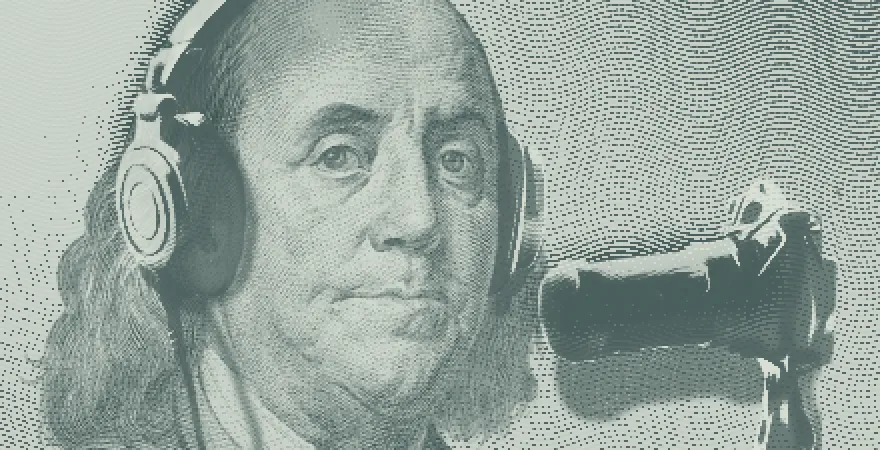[INTRO MUSIC PLAYS]
HOWARD: Hello, and welcome to Noteworthy by the U.S. Currency Education Program or CEP. My name is Howard Williams, and I'm the manager of the CEP. The CEP is responsible for ensuring the integrity of and trust in the U.S. dollar by providing information and training resources to the public. Check out our website at uscurrency.gov to find free information and training resources on U.S. currency. Leading our discussion today will be Maria Hawkins, who is joining us now.
MARIA: Hi. My name is Maria, and I'm a member of the CEP team. And I support domestic and international outreach, and I'm thrilled to be here with you today. In this episode, we are going to uncover the fascinating history of the highest denomination of U.S. currency, the $100,000 certificate. Yes, you heard that right, a $100,000 gold certificate. And you may have plenty of questions. For example, when and why was the certificate printed and is it still in circulation? To answer these questions and more, we are joined by a historian from the Bureau of Engraving and Printing, Nick Bellas. Hey, Nick, thank you so much for joining us today. Could you start by telling our viewers a little bit about yourself and your role?
NICK: Sure. Thanks for having me, Maria. I'm very happy to be here. I work with a great team at the historical resource center in the Bureau of Engraving and Printing. And at the HRC, we collect, catalog, and interpret an expansive collection of material produced throughout the entire history of the BEP.
MARIA: Well, thank you again for being here with us today. And we'll start with the first question. When was the certificate printed?
NICK: The $100,000 certificate was first printed in December of 1934 and for only a few weeks through the end of January 1935.
MARIA: Oh, wow. And can you explain to us why it was printed in the first place?
NICK: Sure. The $100,000 gold certificate was never issued to the public and was not intended, for general use. It was primarily used as an accounting tool for transactions between Federal Reserve Banks. At the time, gold certificates were fully backed by an equal amount of gold bullion, which was held by the Department of the Treasury. That was until the U.S. was taken off the gold standard in 1933.
MARIA: That is so interesting. Is this still considered legal tender or valid for use?
NICK: So, technically, the Gold Reserve Act transferred all the gold supplied to the U.S. government. And as a result, gold certificate circulation was limited only to the Federal Reserve and the Treasury. Also, no currency was thereafter redeemable in gold. Basically, gold certificates are considered legal tender but only between the Federal Reserve Board and the U.S. Treasury. They haven't been in circulation since the 1960sdue to the development of wire transfer technology. And as I previously mentioned, they were never available for the general public to use as a payment method.
MARIA: That makes a lot of sense. Could you tell us about how many $100,000 certificates were printed?
NICK: Sure. There were 42,000 total $100,000 notes printed from 1934 to 1935, but they all have been accounted for and most were destroyed by the government. Private ownership of the certificate is illegal. However, there are a few demonetized specimens on display at institutions around the country, such as the Federal Reserve Bank of San Francisco, our own Bureau of Engraving and Printing. The Smithsonian Institution has one, and the Federal Reserve Bank of Richmond.
MARIA: Thank you for providing that great context. Since we can't see them in person without a trip to one of those institutions, could you describe to our viewers what the certificates look like?
NICK: I'd be happy to. The center of the certificate features a portrait of Woodrow Wilson who served as the 28th President of the United States and to the left of Wilson's picture is the seal of the United States Treasury. It's printed with orange ink and includes the text “gold certificate” and each corner of the certificate displays the numerical value of 100,000.
MARIA: Thank you for such a great description. And for our listeners, if you want to see an image of the $100,000 certificate, you can visit our website at uscurrency.gov. And while you're there, you can explore other historic U.S. banknotes. Now that we know that the $100,000 certificate isn't in circulation, let's talk about the current highest denominations that are in circulation.
NICK: Sure. So, there are 7 Federal Reserve notes, in circulation that are issued today. Those include the 1, the 2, the 5, the 10, the 20, the 50, and the $100, bill notes. However, larger denominations such as the 500, 1,000, 5,000, and $10,000 notes can actually still be found in circulation, although most may be in the hands of currency collectors and private dealers. They are still technically legal tender and valid for making payments. In fact, the U.S. Government has never recalled its currency. It's government practice that all U.S. currency remain legal tender no matter when they were issued.
MARIA: That was really helpful information. Unfortunately, that is all the time that we have today, but thank you so much, Nick, for joining us today. This has been a really fascinating conversation. And to our listeners, make sure that you check out this episode's show notes on the U.S. currency education program website, where you will also find additional resources about the topics discussed today. And remember to subscribe to our podcast so you can stay connected for future episodes. Lastly, please follow us on social media and reach out to us with any questions that you may have. We would love to hear from you and are happy to provide education for your currency needs. See you next time.
[EXIT MUSIC PLAYS]



